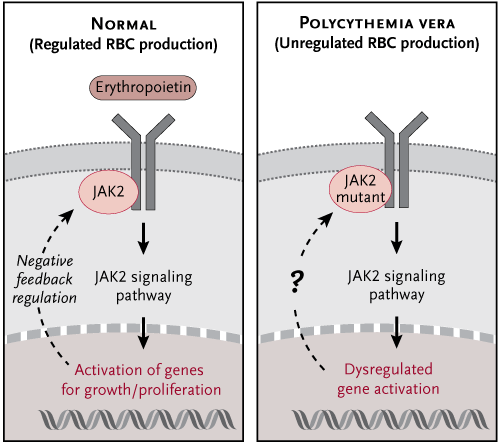What Is Polycythemia Vera?
It’s a blood cancer that begins in the marrow of your bones, the soft center where new blood cellsgrow. If you have polycythemia vera, your marrow makes too many red blood cells, which causes your blood to get too thick. That can make you more likely to have blood clots, a stroke, or a heart attack.
This disease develops very slowly, usually over many years. Although it can be life-threatening if you don’t get any treatment, most people have a good chance of living a long life when they get the right care.
Most people find out they have this condition when they’re 60 or older. But it can happen at any age. It’s more common among men than women.
Although you might have some warning signs like dizziness or feeling tired and weak, lots of things can cause those problems. If you have polycythemia vera, the first sign may be when a routine blood test shows that you have a high number of blood cells.
The treatment you get depends on your age and your particular case. If you don’t have a lot of symptoms, your doctor may just want to check you regularly without any treatment.
It’s natural to worry when you learn that you have cancer. But keep in mind that everyone is different and all cancers aren’t the same. With the support of your doctor, family, friends, and other people who have polycythemia vera, you’ll be in the best position to manage it.
Causes
You don’t “catch” polycythemia vera like you do a cold or the flu. It’s something you get because you have a gene called JAK2 that doesn’t work right. This gene is supposed to make sure your bone marrow doesn’t make too many blood cells.
Your bone marrow makes three types of blood cells: red, white, and platelets. Red blood cells carry oxygen, white fight infections, and platelets clot the blood to stop bleeding.
Most people with polycythemia vera have too many red blood cells. But the disease may also cause you to have too many white blood cells and platelets.
It’s rare, but parents can pass this broken gene to children. Most likely, the problem in your JAK2 gene happened over the course of your life.
Symptoms
At first, you may not notice any problems. When you do start having symptoms, you may have:
- Headaches
- Double vision or seeing dark or blind spots that come and go
- Itching all over your body, especially after you’ve been in warm or hot water
- Sweating, especially at night
- Reddened face that looks like sunburn or blushing
- Weakness
- Dizziness
- Weight loss
- Shortness of breath
- Tingling or burning in your hands or feet
- Painful swelling of a joint
You may also feel pressure or fullness below the ribs on your left side. Those symptoms come from an enlarged spleen, which happens to some people. The spleen is an organ that helps filter your blood.
Without treatment, the extra red blood cells in your veins can cause blood clots that reduce your blood flow. This makes you more likely to have a stroke and heart attack. It can also cause pain (angina) in your chest.

Getting a Diagnosis
If your doctor thinks you might have polycythemia vera, you’ll get a physical exam, including a check of your spleen. He’ll also see if your face is unusually red.
- Do you get a lot of headaches?
- Have you lost weight lately?
- Do you sometimes feel dizzy or weak?
- Have you had shortness of breath?
- Do you sweat a lot at night?
You may get some blood tests, too. These include:
Complete blood count (CBC). Your doctor takes a sample of your blood and sends it to a lab, where a machine counts the number of red blood cells, white blood cells, and platelets. An unusually high number of any of these could be a sign of polycythemia vera.
Blood smear. In this test, your doctor will look at a sample of your blood through a microscope. It’s a way of checking for other diseases that are sometimes linked to polycythemia vera.
EPO level. This test measures how much of the hormone EPO you have in your blood. EPO tells your bone marrow to make blood cells. People who have polycythemia vera have very low levels of it.
Treatment
Polycythemia vera varies from person to person. If you don’t have many symptoms, you might not need to start treatment yet. Your doctor will keep a close watch on your health.
If you do need treatment, the goal is to lower the number of red blood cells and prevent blood clots and other complications. Your options include:
Phlebotomy. This is often the first treatment for polycythemia vera. In this therapy, your doctor removes blood from your vein. It’s a lot like donating blood. The goal is to lower the number of your blood cells. After it’s done, your blood will be thinner and flow better. You’ll usually feel better, too. Some symptoms will get better, such as headaches or dizziness.
Your doctor will decide how often you need phlebotomy. For some people, it’s all they need for many years.
Low-dose aspirin keeps platelets from sticking together. That makes you less likely to get blood clots, which can cause heart attacks or strokes. Most people with polycythemia vera get this treatment.
Medicine to lower blood cells. If you need more than phlebotomy and aspirin, your doctor may prescribe hydroxyurea, a pill that lowers your red blood count and relieves symptoms.
Another drug,interferon alfa, helps the immune system cut back on making blood cells. The drug ruxolitinib(Jakafi) is approved for use in people who aren’t helped by hydroxyurea or can’t handle its side effects.
If you have a lot of itching that doesn’t go away, your doctor may prescribe antihistamines.

Post a comment